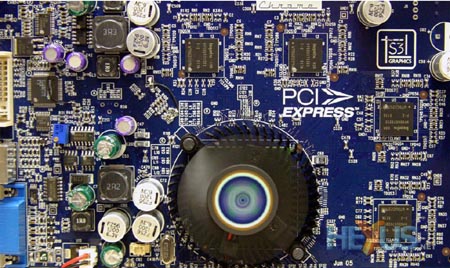Thursday, September 08, 2005
Logitech unveils "smart mouse"
Logitech International SA, one of the world's largest makers of mice and keyboards, has added to its already large range of peripherals with a new mouse that can receive and process wireless communications from a PC.
The Swiss computer peripherals maker said its MX610 laser cordless mouse incorporates 2.4GHz digital cordless technology and an on-board microprocessor. As the mouse is capable of two-way communication with the PC, it can inform users when their mouse battery is low, and notify them when they receive an email or instant message. Quite what the appeal of this function is, especially when most users would be notified by their screen display anyway, is unclear.
One function of the new mouse, however, is its ability to sense if there is wireless interference from other devices, an increasingly common problem with today's numerous wireless devices, and to change channels to establish the most secure connection.
Other features include the ability to sense the power status of the PC. For example, the mouse can sense when the PC has gone into sleep mode or is shut down. The mouse powers down accordingly. This gives the mouse an expected battery life of three months. An indicator light on the mouse lights up when the battery has less than 10% power left.
Also, the mouse uses laser tracking, which gives it the ability to see more surface detail than a typical optical mouse using a red light-emitting diode. This means that laser-based mice can track more accurately and will work on a wider variety of surfaces.
The mouse also has 10 buttons, including volume up, volume down, and mute, for controlling music on the PC. It also includes Logitech's Tilt Wheel Plus Zoom scroll wheel, which allows users to scroll left, right, up and down, and zoom in and out of images, web pages, and so on
The MX610 will be available in the US and Europe at the beginning in October. The price in the US will be $60.
source: http://www.cbronline.com/article_news_print.asp?guid=BE72A422-9ADA-48D2-AD6C-B45709667A69
S3 Graphics Announces Chrome20 Series
They're going after the mainstream market; after the users who want to buy a graphics card, install it, and be able to go forth and play all their games at their monitor's native resolution at default graphics settings. S3G haven't been quiet without reason, they've been working on putting together a product which might help them score some of that mainstream market share.
Hexus had a chance to go behind the scenes and see S3 Graphics' new baby in the flesh manner of speaking.
It's all about power
The Chrome20 series of products use 90nm process technology. S3G have gone for low voltage and cool operating temperatures with Chrome20. They're also claiming the 'highest core clock of any GPU to date', though at the time of writing HEXUS doesn't have any clock speeds to share. However, what we do know is that it will have eight pixel shaders. Given the surge (if you'll excuse the pun) in concerns over power consumption, particularly with graphics cards and processors, performance per watt is the new buzz-phrase echoing around the tech-world and S3 are pitching high performance per watt as one of the key features of Chrome20.Chrome20 products will be available as both mainstream desktop and mobile products, so if Chrome20 really does offer good performance with minimal power consumption, it could be a winner amongst laptop vendors. Looking at one other aspect of Chrome20's manufacturing process, you'll be finding a distinct lack of lead, that means ROHS compliance - well ahead of next year's mandated schedule.
Features
Chrome20 is by no means going to take on the high-end cards, instead looking to provide good performance for your more average user. S3G want Chrome20 to run games smoothly under standard settings. The media brief from S3G states this as being at 'full resolution', which presumably equates to the 1024x768 or 1280x1024 resolutions most users tend to run games at currently.We were offered a chance for some hands on play with a mid-range Chrome20 series desktop board – the machine was loaded with over 40 top games. A quick run of Half Life2 , Far Cry , Halo and a couple of other titles demonstrated that S3G’s new 90nm mainstream card was working without any visual problems and with very playable frame rates – this is the best solution they've had for quite a while and we are keen to get our hands on our sample. The board was a reference design with a tiny little fan-sink (see picture) supporting S3G’s assertion that the power dissipation is very low.

Looking beyond gaming, media playback is also a key feature of the Chrome20 series. S3 Graphics have pride in their hi-def support, with Chrome20 being no exception, supporting hi-def wide-screen and with enhanced HDTV connectivity. We suggested to S3G that they consider putting HDMI on their boards, but we had a 'no-comment' response, so we'll have to wait and see. For those of you not familiar with HDMI, standing for High-Definition Multimedia Interface, it's an uncompressed digital video and audio interface, backwards compatible with DVI. It's something we'll see more of on HDTVs, set top boxes, monitors and graphics cards in due course.
Chrome20 features a new 'Chromotion Programmable Video Engine' which S3 say delivers more features at a better level of performance. Of course, all of this is happening with the minimum of power consumption. S3G continued focus on the media playback and low power is going to make this series of products worth a close look for Home Theatre PCs and Media Center Edition PCs.
When?
We should see the Chrome20 series become available before the holiday season this year. Meanwhile, here's a little peek at a Chrome20 series PCIe card:
Mystery Bulge in Oregon Still Growing
BEND, Ore. (AP) -- A recent survey of a bulge that covers about 100 square miles near the South Sister indicates the area is still growing, suggesting it could be another volcano in the making or a major shift of molten rock under the center of the Cascade Range.
Recent eruptions at nearby Mount St. Helens in Washington state have rekindled interest in the annual Sisters survey and its findings.
Oregon has four of the 18 most active volcanoes in the nation -- Mount Hood, Crater Lake, Newberry and South Sister. A recent U.S. Geological Survey report said monitoring is inadequate at all of them, with only basic monitoring at about half of the active volcanoes.
Image Galleries | ||||
Unlike the volcanoes, the bulge gets an extensive annual survey to track its growth. Spread out across an area nearly as big as the city of Portland, It's centered about three miles southwest of the South Sister, about 25 miles from Bend.
The results of the late August survey won't be ready for weeks, but scientists have reached some conclusions about the bulge from past monitoring.
They say it probably began growing in 1997 and has been rising ever since at a rate of about 1.4 inches a year. It was first observed from space using a relatively new imaging technology known as radar interferometry that can measure changes in the Earth's surface.
The likely cause of the bulge is a pool of magma that, according to Deschutes National Forest geologist Larry Chitwood, is equal in size to a lake 1 mile across and 65 feet deep.
The magma lake is rising 10 feet each year, under tremendous pressure, and it deforms the Earth's surface as it expands, causing the bulge.
Other causes could be anything from the birth of a new volcano -- a fourth Sister in the making -- to a routine and anticlimactic pooling of liquid rock, researchers say.
"The honest and shortest answer is, we don't know,'' said Dan Dzurisin, a USGS geologist.
Dzurisin recently led a three-person leveling crew on a slow walk across the top of the bulge. They were hoping to detect any change in its surface using survey equipment accurate to one-sixteenth of an inch for every mile measured.
Dzurisin's survey data, in concert with space imaging and satellite positioning measurements from two dozen fixed points on the bulge, give scientists an idea of the bulge's depth and size.
Additional information from seismographs and chemical monitoring of area springs reveal movement of the magma underground. A swarm of 350 small earthquakes in March 2004 indicated magma was on the move, but the bulge has been quiet ever since.
Whether the magma will move again or ever reach the surface is a mystery. But if it did, geological history suggests it would result only in small cinder cones that spew ash and lava.
The good news is that such an eruption likely would not seriously affect any population centers, Chitwood said.
Such cones are the most common volcanic features on Earth, he added. Central Oregon has about 600. Basalt flows have occurred in the area of the bulge every 1,000 to 1,500 years for the past 4,000 years, he said. And the area is due for another.
"The bulge is on time,'' Chitwood said. "The bus has arrived.''
- The Bulge Seen in 2001 Satellite Data
- The Science and History of Volcanoes
- New Volcano Threat: Just When You Think It's Safe ...
source:http://livescience.com/forcesofnature/ap_050906_sisters_bulge.html


